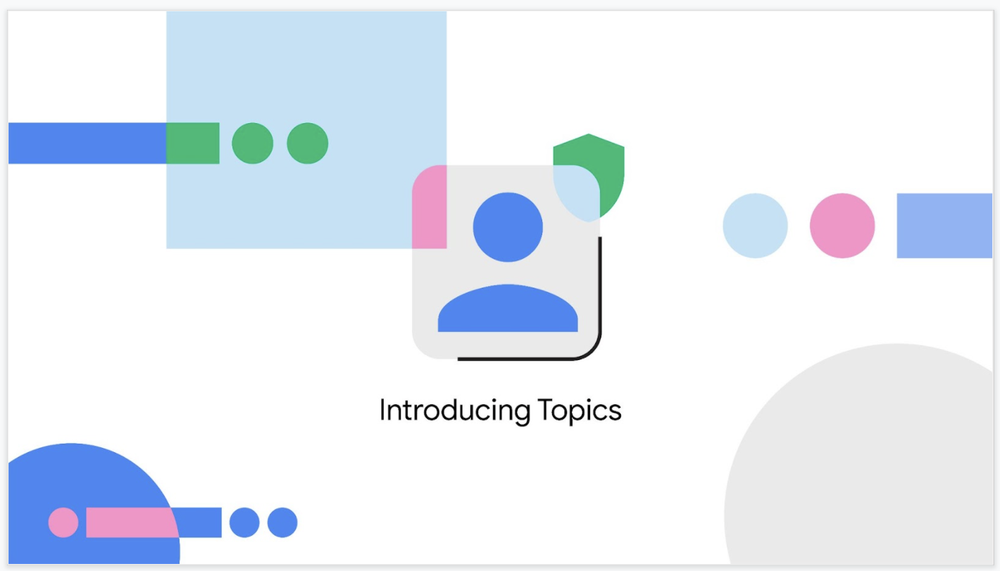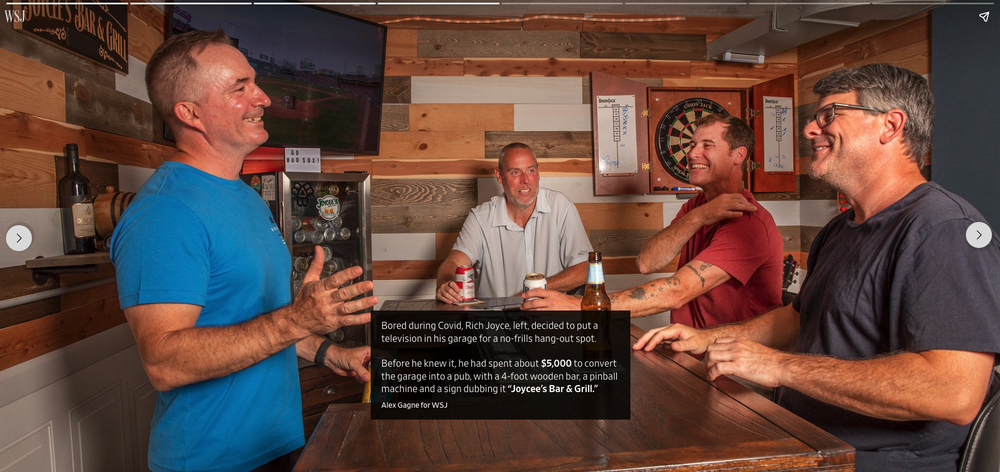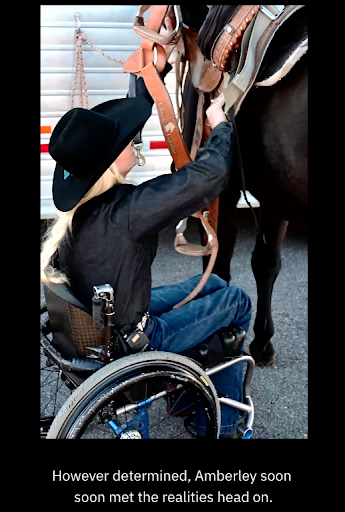Friday 28 January 2022
Thursday 27 January 2022
Offers on Google Play: a new destination to find great deals
Since 2012, Google Play has been a one-stop shop for discovering and enjoying your favorite apps, games and digital content. This week we’re launching “Offers” — a new tab in the Google Play Store app to help you discover deals in games and apps across travel, shopping, media & entertainment, fitness, and more. The rollout is underway and it will be available to more people in the United States, India and Indonesia over the coming weeks, and more countries later in 2022.
Sections like “Offers for apps you might like” help you easily find deals that are relevant to you. We’re partnering with developers of some of the top apps and games on Google Play to add new, fresh deals every day. As Allison Boyd of Strava explains, “Offers is a win-win. We get an additional touchpoint with people to share information about a valuable promotion or update, and people can easily redeem the offer by opening the Strava app from the Offers tab.”
Find limited time deals, in-app rewards and more
Here are a few of the deal types that you can expect to find over time:
- Sales on games and in-game items: find limited-time deals on magic orbs, tokens, and more.
- Rewards and bundled offers: see what apps are offering you free delivery, free rides, and other rewards.
- Discounts on movies and books: find the latest sales on movies and books to rent or buy.
- Try something new: browse apps that are offering 30 days free, and other extended trials at no cost.
When you see Offers in the bottom bar of the Google Play Store app on your Android mobile device, be sure to check it out.
by David Winer via The Keyword
How Divya believed and bet on herself to get to Google
Welcome to the latest edition of “My Path to Google,” where we talk to Googlers, interns and alumni about how they got to Google, what their roles are like and even some tips on how to prepare for interviews.
Today’s post is all about Divya Gonnabathula, a Client Success Acceleration manager based in Hyderabad, India who’s always gravitated toward new experiences — including here at Google!
What do you do at Google?
I’m a Client Success Acceleration manager leading a team of digital marketing strategists. We collaborate with sales teams in the UK to help our customers succeed using Google Ads. As a manager, I also make sure I spend time with my reports in team and individual meetings — I’m passionate about leading with respect.
What’s something about you that might surprise us?
I consider myself a nomad. Over the years, I’ve lived in many different parts of India. I was born in Vijayawada, went to school in Kolkata, attended college in Bhubaneswar and worked in many cities around the country. Thanks to these experiences, I can easily connect with people from different cultural backgrounds and have a keen interest in languages — I speak six and I’m picking up a seventh!
Why did you apply to Google?
Like so many others, Google’s products and services are part of my daily routine. I can’t imagine a day without searching for things online, watching YouTube or checking emails. The opportunity to create such impact at scale inspired me to look for open roles on the Google Careers website. Once I found one that matched my career goals, I applied.
What was the journey to your current role like?
I’m a sales and marketing professional, and I’ve spent most of my career in the Indian consumer goods industry. A few years ago, I jumped to consumer tech — which led me to Google. By the time I started, I was eight months pregnant. Joining a new organization always comes with a lot of change — but the thought of going on maternity leave in just one month, combined with onboarding remotely, was pretty overwhelming. Luckily, Google made things easy. My recruiter, manager and onboarding “buddy” helped me ease into the company, creating a custom onboarding plan and encouraging me to build a support network on my team.
How did you prepare for your interviews?
I started by brainstorming questions the interviewer might ask and practicing my responses. I also reflected on my previous roles, including my strengths, management experiences and leadership philosophies. I brushed up on my knowledge of Google Ads products, too.
What’s one of your favorite things about working at Google?
My teammates! The opportunity to work with some of the greatest minds in the industry is a very big motivator, because I believe we learn so much from the people around us. In order to bring my best self to work, it’s important that I have colleagues and managers who inspire me.
Any advice for your past self?
Don’t doubt yourself. I was in a marketing role when I applied for this sales position at Google, so I was worried that I wouldn’t be a good fit. But I realized through the hiring process that having diverse skills and experiences is actually really valuable.
Any tips for aspiring Googlers?
Throughout my Google interview process, I was determined to be myself. I made sure to show my personality in all of my interviews and approached them as candid conversations with future colleagues and managers. This gave me a better understanding of what I was signing up for, and helped my interviewers see how I would really fit into the role.
by Jason Rowland via The Keyword
Hash Code 2022 returns with a new look
Registration is officially open for Hash Code, Google’s team-based programming competition! On February 24, developers around the globe will team up to test their coding skills and have some fun. Whether you’re new to coding or a seasoned expert, there’s something for everyone. Here’s what you can expect from Hash Code 2022:
Compete on a new platform
Hash Code is excited to announce that participants will compete on a new platform — the same one used by Code Jam and Kick Start — so participants will all get the same experience across Google's Coding Competitions. You can test it out after you and your team register for the competition and try out the practice problem available at g.co/hashcode.
Work like a software engineer
Hash Code problems are written by Google software engineers and are based on real engineering problems. Hash Code is a great way to build your engineering skills and learn something new. Because there is no right answer, your team can submit multiple solutions during a round. — which is exactly how our engineers work on a daily basis at Google.
Want a taste of what Hash Code problems look like? You can find all problems from previous years of Hash Code in the archive.
Team up with friends (or meet some new ones)!
In order to compete in the Qualification Round, you must be on a team of 2-4 people. If you don't have a team, don't worry! You can still register today and find teammates later using our Facebook group.
Amp up your resume
Hash Code is a great way to grow your coding skills and experience how real software engineers solve real problems. Every team that submits a solution and scores one point in the Qualification Round will receive a certificate in their Coding Competitions profile. This certificate can be posted to social media, added to a job profile or used for your resume.
Hash Code 2022 kicks off with the Qualification Round on Thursday, February 24 at 9:30 a.m. PT and wraps up with the World Finals in April. Register at g.co/hashcode by February 23 and spread the word!
by Torey MarkowitzHash Code via The Keyword
Wednesday 26 January 2022
This creator turned donuts into dollars
Google for Creators recently launched The Conversation, a new YouTube series spotlighting the experiences of women of color creators. This month, we’re featuring designer, photo stylist and donut aficionado Samantha Ushiro, the talent behind the successful online brand Aww Sam. Learn more about Sam below and check out the full interview.
Samantha Ushiro’s love for donuts, confetti, bright colors and vintage fashion led to an unexpected — and successful — career move. Today, her Aww Sam brand has nearly 300,000 followers across her web properties, including her Pinterest profile, which receives 2.4 million monthly views. She’s also partnered with brands like Refinery29, Bustle, HGTV and Brit + Co.
Sam made a leap of faith to get where she is today. She was studying industrial design at the Parsons School of Design in New York. For her final project, she created a photo book of handmade, colorful donuts decorated in her whimsical style. A blogger since high school, Sam decided to post some of the photos online. “People were asking me, ‘What’s the recipe? How do I make these?’” Sam recalls. “That’s how it all started.”
Sam began posting her work on Instagram. Brands took notice of Sam’s upbeat, retro style, and paid gigs started rolling in. “I realized, OK, I could make a career doing this,” Sam says. She left her job in 3D modeling to dive into online content creation full time.
In 2015, Sam launched Aww Sam, a creative lifestyle blog “with a focus on making every day fun.” She expanded her content to include party planning, crafting, vintage fashion and home décor. Her audience ate it all up.
Sam now toggles between New York City and her home in Austin, Texas, which she shares with her husband, Kyle, and new baby Kiki. Here, Sam shares a few ingredients from her recipe for success.
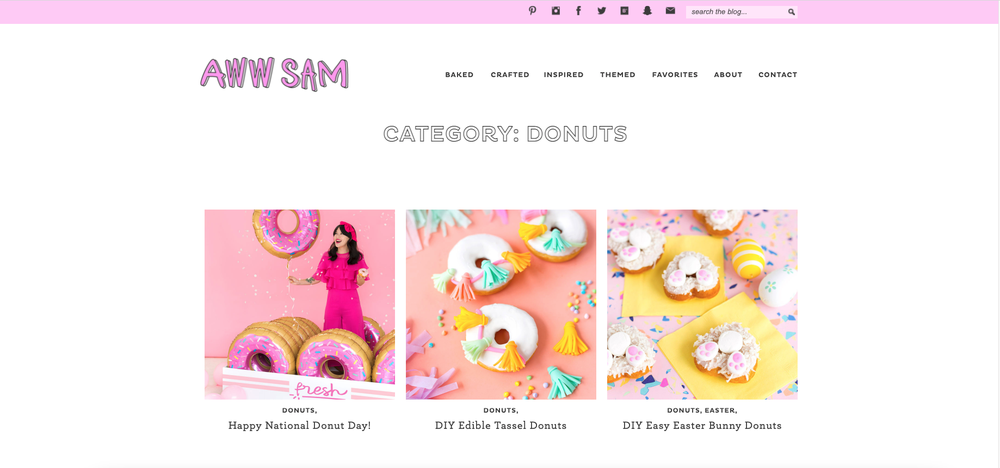
Sam Ushiro’s love for decorated, handmade donuts launched the Aww Sam brand.
Commit to your passion
In the beginning, Sam was juggling college, a job and her social media content. Like so many aspiring creators, Sam had to choose where to focus her time and energy. “Some people wait until their social media work surpasses their salary, then they make the leap full time,” Sam shares. “It was hard for me to do both at once.” She decided to take a chance and become a full-time content creator. “I figured, if this fails, I can go back to my industrial design career.” Sam never had to revert to plan B, as Aww Sam became even more successful than she imagined.
Start with what you have
Sam didn’t start out with fancy equipment or a studio. Working out of her one-bedroom apartment in New York, she taped paper to the walls to create a photography backdrop. “I used Photoshop to extend the colored backgrounds,” Sam shares. She had a flip phone (no smartphone), so she improvised with the tools available. “I used a digital camera,” Sam explains. “I would email the photos to myself, and then I’d go on my iPod touch and post them on Instagram.”

Sam’s husband, Kyle, and baby Kiki are part of the Aww Sam experience.
Find inspiration in unexpected places
Sam’s design aesthetic is uniquely her own. But she’s drawn inspiration from outside of the Aww Sam orbit, too. “I look at other creative things, like films, graphic novels and surrealist art,” Sam says. “You can gather inspiration from stuff that’s not directly related to your work.”

Sam’s Jell-O crown cake is inspired by vintage recipes, when Jell-O was a kitchen staple.
Use your platform for social advocacy
Sam has built her brand on spreading joy. But she also uses her platform to educate her audience. Her Instagram Stories cover the Black Lives Matter movement and other important issues, including the rise in violence against Asian American and Pacific Islander communities. In one post, Sam shared her experience growing up as a Japanese American, and how her grandparents were relocated and confined in U.S. internment camps during World War II. The post enlightened her audience, “some of whom didn’t know Japanese internment camps existed,” Sam says.

Sam shared her experience growing up as a Japanese American with her followers.
Sam hopes her content serves as a bright spot in her followers’ social media feeds. She encourages other creators to start posting and see where their journey takes them. “I think all creative work is valid,” Sam says. “Even if you don't think you've done a good job, you still made this thing. You made something out of nothing. And that in itself is still valid.”
Want to hear more? Check out the full video interviewwith Sam on The Conversation.
by Chanelle Garcia via The Keyword
Lessons from helping 10 million during the pandemic
2022 marks the third year of the pain of the COVID-19 pandemic. Though we’ve yet to see the long-term impact it will have on how we live, work, study and grow, I’ve never seen a time where technology has been as helpful to as many people as it has been over these last three years.
The same technology that has kept so many going will be key to the economic recovery, but we must also make sure no one is left behind.
In 2015, when I first started this role at Google, the EU released a report highlighting a digital skills gap that threatened to leave a million jobs unfilled. Seeing a unique challenge and opportunity for Google to help, we launched Grow With Google, which aims to help accelerate economic recovery through our technology, tools and training. Through Grow with Google, we’ve trained 88 million people around the world in the skills they need to build their career, launch or grow their own business.
With the onset of the pandemic, we sought to build on these efforts. The acceleration of technology was keeping businesses afloat and helping communities connect — but it also risked leaving some people behind.
So in June 2020 we set ourselves a new target, pledging to help 10 million people and businesses in Europe, the Middle East and Africa (EMEA) find jobs, digitize and grow by the end of 2021. This important milestone has now been reached, and surpassed.
We approached this challenge by:
Providing businesses with the tools they need to thrive
Research has found 80% of small businesses increased their use of digital tools during the pandemic. So we’ve launched more than 200 new features since March 2020.
For example, with Business Profiles, we made it easier for businesses to manage their presence directly on Google Search and the Google Maps app and connect with customers online. These tools have helped businesses and people adjust and thrive during the pandemic. In fact, boutique French retailer Indira de Paris now attributes 70% of their sales to digital, thanks to these features.
We have also launched new features on Search and Google Maps enabling restaurants to inform customers they now do delivery — or for local stores to say they offer curbside pick-up. People can now find this information on Search and Maps for more than six million restaurants and retailers in Europe. To help retailers to connect with more customers, we made it free for retailers to list their products on the Shopping tab throughout Europe, the Middle East and Africa. To help retailers stand out online, in over 10 EMEA markets, we launched tailored recommendations for every business with our new tool, Local Opportunity Finder.
Supporting people and businesses to learn new digital skills
To make the most of the digital opportunities available to them, people and businesses need the right skills. Across Europe, the Middle East and Africa, as part of our Grow with Google efforts, we focused on providing digital skills training.
We have worked alongside partners to launch initiatives aimed at supporting local businesses and communities to make the digital transition. With the German Retail Association (HDE) we launched the ZukunftHandel initiative, which has provided over 70,000 retailers with coaching and other support.
Long before the coronavirus, it was clear the jobs of the future would require anew set of digital skills. McKinsey now estimates that more than 25% of people may need to transition new jobs because of the pandemic. In response, we launched new Google Career Certificates to help people reskill for roles in high-growth areas such as IT support, project management, data analytics or UX design. People like Jelena in the UK have also benefited from the 100,000 scholarships we are providing in partnership with local governmental and non-governmental organizations. Jelena participated in a Project Management course from the Google Career Certificate program and is now a digital project coordinator for various charitable initiatives.
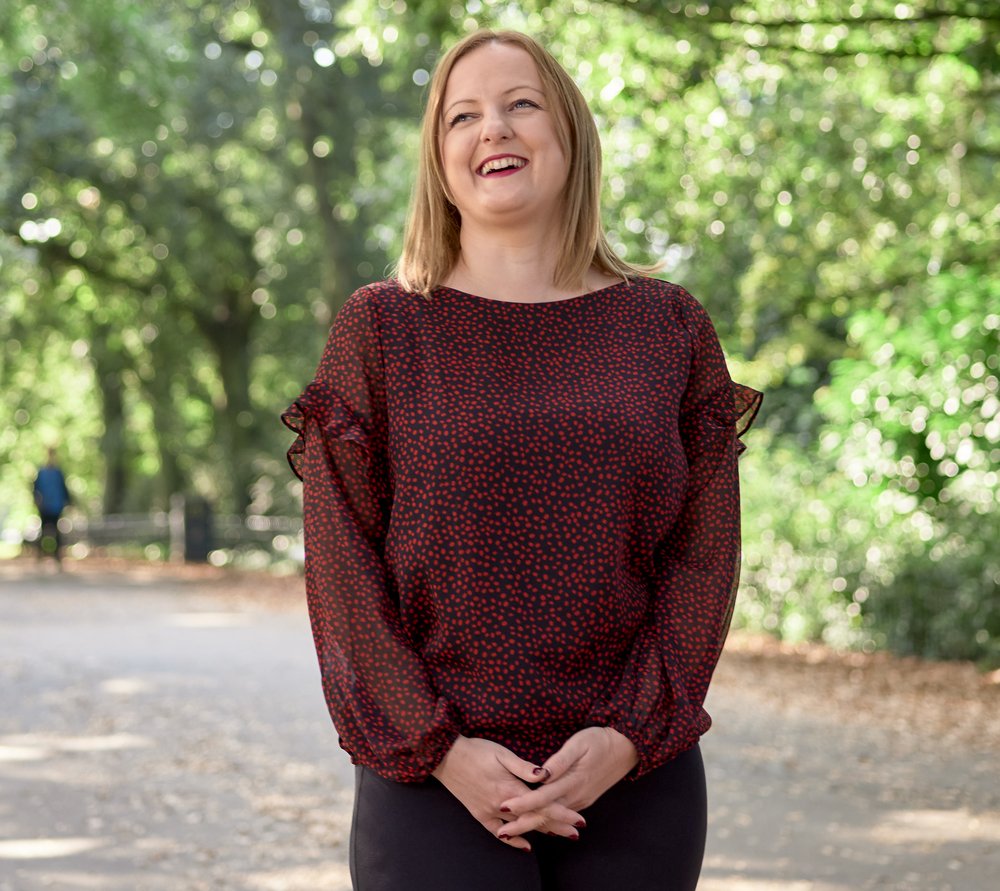
A picture of in Jelena Stephenson in Serbia who completed the Project Management course from the Google Career Certificate programme
From our experience we feel there are five key lessons to share as we all continue the journey to economic growth and recovery in 2022.
1. The digital transition will continue at pace in 2022.
The future will be about businesses having the right skills and using the full range of digital tools to take advantage of the opportunities technology presents. Research has found that small businesses in Europe with a sophisticated use of digital tools were able to build a “digital safety net” during the pandemic, resulting in 80% better sales and 60% better revenue. For example, German fashion company das schöne leben ran their first in-house Search campaign during the pandemic and has tripled their direct online orders with customers of all ages throughout Germany.
2. Obtaining new skills will support the transition and expand the digital opportunity to more
Research by Google and McKinsey from 2020 shows that more than 90 million people in EMEA may need to learn new skills for future jobs, and that some people will need to change careers entirely. The past two years have only accelerated those changes further. Our work has provided us with numerous examples of businesses and individuals making the most of this opportunity. Noemi in Italy learned new skills so she could help local small businesses to digitize and grow, while Alba in Madrid used her Career Certificate to secure a job in IT support. Our Grow with Google and Career Certificate programs will continue to provide people with these skills.
3. For lasting impact, we must ensure that this opportunity is open to all
The pandemic has reinforced growing inequalities both between economies and within them. We know certain groups are more impacted than others: those without a college degree, ethinic minorities and women. To address this, we need new ways of thinking. We know that digital skills and tools, with the right support, can unlock everyone’s potential. In our efforts, we have seen countless examples of this — from Ibrahim in Italy, to the many women-owned businesses using Google tools across Europe. We will continue to work hard to reach everyone and will continue to work with a diverse group of organizations like MExoxo in Greece, which supports women, refugees and LGBTQ+ women in entrepreneurship.
4. Current challenges call for greater collaboration between organizations, communities and governments.
Partnerships have been the cornerstone of our work in supporting communities and governments. In France, working in partnership with Pole Emploi in some regions has helped job seekers identify gaps in digital skills and ways to access them. In 2022, expanding the digital opportunity and driving digitization should see this work continue. This will require continued collaboration on policy efforts, such as those led by the European Commission, as well as careful consideration of the regulations that will support a digital-led recovery.
5. The green economy will be the bedrock of the present and future.
The pandemic has demonstrated our collective ability to tackle major challenges — but coronavirus is not the only crisis we are facing. As we look to recover from the pandemic, the same focus must be given to fighting the climate crisis. Entrepreneurs are already working with governments and organizations to develop the technologies capable of addressing this challenge. Through theGoogle for Startups Accelerator: Sustainable Development Goals Project 2030 and anchoring over €2 billion of green infrastructure investments in Europe by 2025, we are backing those who are striving to find these solutions. We also want to help businesses and individuals make the right choices, working with SolarPower Europe’s #SolarWorks program to raise awareness of the diverse range of careers available in solar as well as promoting sustainable choices through the products we provide. In the U.K. we have worked with Planet Mark to offer training to help small businesses their journey towards sustainability.
The pandemic has presented enormous challenges to communities and economies across the world. While difficult work is still required to respond to and recover from the public health crisis, our work in helping 10 million people and businesses in Europe, the Middle East and Africa to find jobs, digitize and grow has underlined to me that there are also enormous opportunities. The future we need to build is an inclusive, sustainable and digitally accelerated one — and we are here to play our part.
by Matt BrittinGoogle Europe, Middle East and Africa via The Keyword
Tuesday 25 January 2022
How Google puts you in control of your location data
You may have seen news about lawsuits brought against Google concerning how we handle location data. These suits mischaracterize and inaccurately describe the settings and controls we provide users over location data.
Today, a court in Arizona made a significant legal ruling against the Arizona Attorney General. The AG is somehow claiming this as a big victory but in reality, a judge rejected his central argument. Unfortunately, just before today’s decision, four other state attorneys general rushed to file similar lawsuits making similarly inaccurate and outdated claims.
We wanted to take this opportunity to set the record straight about the location settings we offer, and how you are in control of your location data.
All smartphones use location data — it’s integral to how they work. It’s collected and used by network operators, device makers, apps, websites and operating systems. For our part, location makes Google products work better for you — it’s what helps you navigate around a traffic jam, helps you find your phone when you’ve misplaced it, and lets you find a pizza shop in your neighborhood instead of suggesting one in a different state.
We recognize that you have a lot of decisions to make around the use of location data by various apps and services. That’s why we’ve worked hard over the past few years to build more control and transparency directly into our products to make location easy to understand and simple to manage:
- Easy-to-use settings: We offer settings like Location History, which creates a timeline of where you have been, saved to your Google Account. You can delete this data or pause saving it at any time. Web & App Activity saves activity like the things you do on Google sites and apps, including associated info like location. Again, you can delete this data or pause saving it at any time.
- Auto-delete by default: Two years ago, we updated our data retention practices — in addition to turning Location History and Web & App Activity off, you can choose to automatically auto-delete them after a set period of time (3 months, 18 months or 36 months). (For new users, the default is to auto-delete them after 18 months).
- Transparency: You can instantly see your settings and manage them right from your favorite Google products — for example, on every search results page, we indicate the location information that was used to deliver results, and enable you to change your settings directly. And if you have Location History enabled, we send monthly and annual emails to remind you about places you’ve visited, along with easy access to your settings.
- Maps Incognito mode: With Google Maps Incognito mode, the places you search for or navigate to in Google Maps won’t be saved to your Google Account.
- Advertisers and apps: Location data helps you get relevant offers such as local pizza restaurants but we never sell your location data to advertisers — or to anyone. And from Android 10 onwards, you can choose to share your device’s location with third party apps only while they’re in use — or not at all.
As we design our products, we focus on three important principles: keeping your information safe, treating it responsibly, and putting you in control. We aim to strike a balance between offering granular customization for users who want to pick and choose between options, while keeping our controls simple and easy to understand. We will continue to focus on providing simple, easy-to-understand privacy settings to our users, and will not be distracted from this work by meritless lawsuits that mischaracterize our efforts.
by Keyword Team via The Keyword
Watch With Me on Google TV: Chris Paul’s watchlist
Movies and TV can make us laugh, cry and even shape who we are. Our watchlists can be surprisingly revealing. We’re teaming up with entertainers, artists and cultural icons on a new Watch With Meseries on Google TV to share their top picks and give you a behind-the-scenes look at the TV and movies that inspired them.
Remember waking up on Saturday morning and catching up on the latest episode of your favorite show before it ended? Chris Paul does. Before being crowned the king of the basketball court, Chris was just another kid from North Carolina who loved watching TV with his brother. “Back then, you couldn’t record your show or get it on demand to watch later,” he says. “You had to watch it when it came on.”
TV and movies were a way for him to learn about the world. “Growing up without social media made a lot of things different,” he says. “My brother and I used to get home from school and watch movies four, five days in a row. TV gave us a fresh perspective and a way to see what our dreams could be. As I got older, I looked back and saw how these shows and movies shaped my life.”
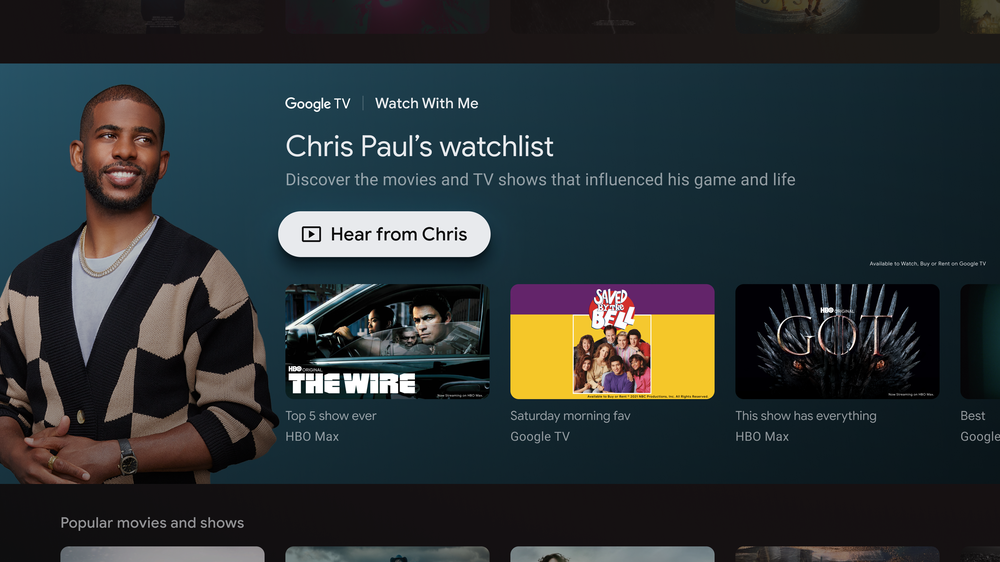
What does your watchlist say about you?
Chris Paul: My watchlist says that I’m someone who has watched a lot of different things, and has a pretty diverse taste. I like the stories being told and the impact that TV and movies have on you.
What’s your favorite genre?
Chris Paul: My favorite genre would be comedy. I love to laugh. The stuff that makes a good comedy are the punchlines, the characters and the storyline. I think you can naturally tell when things are sort of off the cuff… a good comedy can’t be predictable.
What are some must-watches in your household?
Chris Paul: At home, we love getting together with the kids to watch TV, whether it be movies or shows. But I had a few movies that my wife had to see before we got married – like I asked her if she had seen them and she said no. We weren't going to get married until she saw “The Last Dragon” because that movie is a staple in just culture.
What’s something you love watching that might be unexpected?
Chris Paul: I don’t just love watching comedies, I like watching horrors too. But, something that I really liked to watch, probably nobody would expect is “Below Deck.” It’s interesting to watch a reality show about people working on yachts and what their life is like.
Do you like watching TV with the captions on or off?
Chris Paul: I’m a captions-off person, but now I watch with captions on. My wife likes having the captions on and always grabs the remote to turn them on to listen and read at the same time.
Who’s your favorite person to nerd out about shows and movies with?
Chris Paul: I love talking to my brother CJ about shows and movies more than anything. And I think people probably hate when me and my brother are around because all we do is quote lines from shows and movies on the regular. No matter what it is, that's all me and my brother do.
Check out Chris’s watchlist and catch some of his favorite lines on Google TV, rolling out over the next few days. Tell us your favorites using #WatchWithMe!
by Ashley Lu via The Keyword
Today is the .day
Today, Google Registry is launching the .day top-level domain — a secure domain that brings attention to any day. In honor of the days coming up in this new year, we've rounded up 22 of our favorite .day websites:
Bring attention to a cause you care about
These nonprofit organizations are using their .day domains to raise awareness around specific issues or causes that help make the world a better place for everyone.
1. Wildlife.day by World Wildlife Fund
2. Accessibility.day by GAAD Foundation
3. Freedom.day by International Justice Mission
4. Tues.day by Giving Tuesday
5. Rednose.day by Comic Relief
6. SesameStreet.day by Sesame Street
7. Transvisibility.day by Human Rights Campaign
8. Veterans.day by Team Rubicon
9. Equalpay.day by National Women’s Law Center
10. MLK.day by NAACP
11. NativeNonprofit.day by Native Ways Federation
Amplify your brand or persona
Whether you’re a company building a brand or an influencer growing a fanbase, .day is a great way to register a memorable domain that promotes your message.
12. Nutella.day by Ferrero
13. Felicia.day by Felicia Day
14. Magic.day by Justin Willman
15. Wedding.day by The Knot International
16. Valentines.day by FTD
Build your community
The .day domain ending makes it easy to find short, memorable domain names, which make it even easier for your communities to find your website.
17. Community.day by Niantic
18. Braille.day by National Federation of the Blind
19. Easter.day by YouVersion
20. Ramadan.day by Yaqeen Institute
21. Yoga.day by Hindu American Foundation
22. HolocaustRembrance.day by World Jewish Congress
Starting today, you can register your own .day domain as part of our Early Access Program for an additional one-time fee. This fee decreases according to a daily schedule through the end of January. On February 1 at 8:00 am Pacific time, .day domains will be publicly available at a base annual price through your registrar of choice. To learn more about pricing and our participating partners, visit new.day.
Will you celebrate a birth.day or share a passion? Will you engage more deeply with your community? No matter what you do today, we hope you’ll seize your .day domain and make it a great experience.
by Christina Yeh via The Keyword
Get to know the new Topics API for Privacy Sandbox
We started the Privacy Sandbox initiative to improve web privacy for users, while also giving publishers, creators and other developers the tools they need to build thriving businesses, ensuring a safe and healthy web for all. We also know that advertising is critical for many businesses, and is a key way to support access to free content online.
Today, we’re announcing Topics, a new Privacy Sandbox proposal for interest-based advertising. Topics was informed by our learning and widespread community feedback from our earlier FLoC trials, and replaces our FLoC proposal.
With Topics, your browser determines a handful of topics, like “Fitness” or “Travel & Transportation,” that represent your top interests for that week based on your browsing history. Topics are kept for only three weeks and old topics are deleted. Topics are selected entirely on your device without involving any external servers, including Google servers. When you visit a participating site, Topics picks just three topics, one topic from each of the past three weeks, to share with the site and its advertising partners. Topics enables browsers to give you meaningful transparency and control over this data, and in Chrome, we’re building user controls that let you see the topics, remove any you don’t like or disable the feature completely.
More importantly, topics are thoughtfully curated to exclude sensitive categories, such as gender or race. Because Topics is powered by the browser, it provides you with a more recognizable way to see and control how your data is shared, compared to tracking mechanisms like third-party cookies. And, by providing websites with your topics of interest, online businesses have an option that doesn’t involve covert tracking techniques, like browser fingerprinting, in order to continue serving relevant ads.
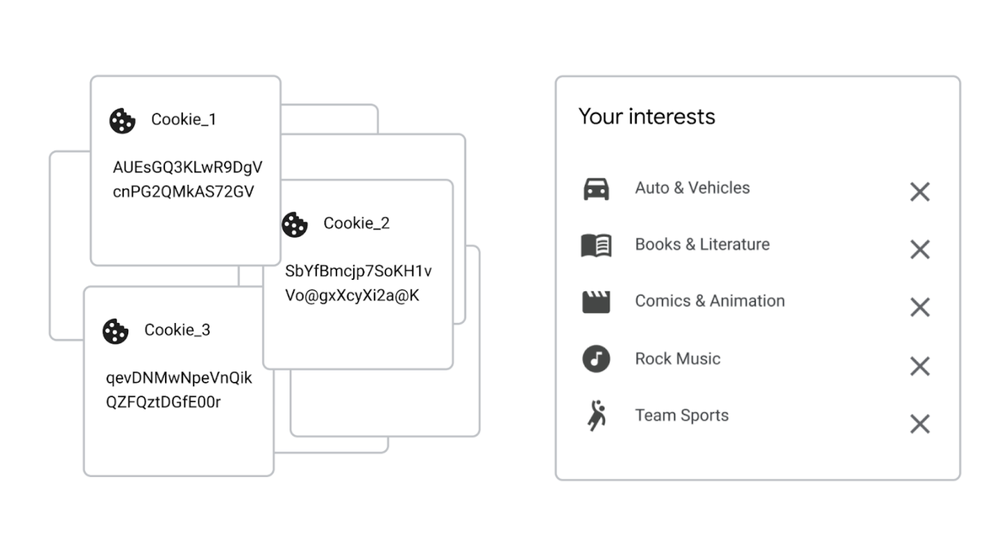
Example illustrations of what you can see about 3rd party cookies (left) vs Topics (right). In Chrome, we plan to make Topics easier to recognize and manage for users.
To learn more about the details of the Topics proposal, including other design features that preserve privacy, see the full technical explainer. Soon, we will launch a developer trial of Topics in Chrome that includes user controls, and enables website developers and the ads industry to try it out. The final design of the user controls and the other various technical aspects of how Topics works will be decided based on your feedback and what we learn in the trial.
This is a busy time for the Privacy Sandbox. We recently worked with the U.K.’s Competition and Markets Authority (CMA) to offer revised commitments to ensure our proposals are developed in a way that works for the entire ecosystem, and later this week, we'll be sharing more details about the FLEDGE and measurement technical proposals with developers. The Privacy Sandbox is one of the most ambitious, important efforts we’ve ever undertaken, and we’re profoundly grateful for the engagement, feedback and partnership from everyone who’s participated.
by Vinay GoelChrome via The Keyword
Monday 24 January 2022
More digital skills training in the Latino community
Ver abajo versión en español
Alex Corral was working in his family’s restaurant when he suffered an injury on the job. That moment made him stop to reflect about his career path, and ultimately look for a change.
Alex always had an interest in IT, but during the time of his injury he decided to act on this interest, so he enrolled on the Google IT Support Career Certificate. Earning his Certificate gave him the confidence to apply for jobs in the field, which led him to his current job with Truckstop.com, a software company which helps optimize freight moving. Alex credits Google Career Certificates as the reason he was able to pivot careers and get his start in the IT sector.
Everyone should have the opportunity to participate in today's increasingly digital economy, but in occupations requiring digital skills, which will represent two thirds of jobs by 2030, members of the Latino community in the U.S. are significantly underrepresented. Over the next decade, members of the Latino community will grow to represent 21% of the workforce, and 78% of net new workers.
To be prepared for in-demand, high-paying jobs and to close the existing gap in digital skills, it’s crucial that members of the Latino community get easy access to education and credentials. Investing in training and support for job seekers in the community will drive economic mobility and equity. So today we’re announcing three initiatives to help open doors to higher-paying jobs and entrepreneurial ventures that can grow into long-lasting careers.
Digital skills training for 200,000 students
In 2021, we announced the Grow with Google Career Readiness Program expansion to reach Hispanic-serving Institutions (HSIs). Today, in partnership with the Hispanic Association of Colleges and Universities (HACU), we’re announcing the first group of more than 20 HSI partner institutions. With the support of Google’s $2 million investment, career counselors and faculty from across the country — from McAllen, Texas to Pueblo, Colorado — will lead the effort to train 200,000 college students in the Latino community with learning pathways built by Google and focused on the digital skills needed to help them land internships and jobs. Our HSI partner institutions will also award Google Career Certificate scholarships to participating students to help them continue to build necessary skills to succeed in high-growth jobs.
More access to our career-focused training
Google.org is announcing $5 million in grants to UnidosUS, the League of United Latin American Citizens and the Hispanic Federation to help members of the Latino community prepare for jobs in the digital economy. They will work with local affiliates across the U.S. to reach over five thousand Latino jobseekers. Learners will receive access to training opportunities to grow their digital skills, and access to Google Career Certificates and wraparound support, too. Additionally, Google.org is supporting the Aspen Institute Latinos and Society Program with a grant to help advance research on the challenges non-native English-speaking immigrants and first-generation Americans face in acquiring digital skills.
Google Career Certificates now support Spanish-language learners
The Google Career Certificates have helped tens of thousands of job seekers in the U.S. acquire digital skills and find pathways to well-paying, in-demand jobs. As of today, all our Google Career Certificates are available with Spanish subtitled video lessons and fully translated pages, reading materials, quizzes and documents. Our Career Certificates prepare learners for jobs in data analytics, project management, user experience design and IT support. No previous experience or knowledge is required to enroll, and learners can be job ready in three to six months.
These announcements build on over $20 million in Google.org grants to advance economic mobility in the Latino community, and our work to create tools to help the community in the U.S. grow their digital skills. That includes our library of free Spanish-language training, including workshops via Grow with Google, minicourses on the Google Primer app and video lessons from our Applied Digital Skills program.
With new investments helping to create a more equitable workforce, we’ll keep building new resources for people like Alex. To learn more about our tools and resources for the Latino community, visit grow.google.
Más entrenamiento en habilidades digitales para la comunidad latina
Alex Corral estaba trabajando en el restaurante de su familia cuando sufrió una lesión laboral. Esa ocasión lo hizo frenar para reflexionar sobre su rumbo profesional y, finalmente, buscar un cambio.
A Alex siempre le interesó la tecnología de la información (TI), y durante el tiempo que estuvo lesionado, decidió seguir su interés; por lo tanto, se inscribió en el Certificado de carrera en Soporte de TI de Google. Obtener su Certificado, le otorgó la seguridad para postularse para trabajos en el área; así llegó a su empleo actual en Truckstop.com, una compañía de software que contribuye a mejorar el transporte de carga. Alex atribuye a losCertificados de carrera de Google el haber podido dar un giro en su profesión e iniciarse en el sector de TI.
Todos deberían tener la oportunidad de participar en la pujante economía digital de hoy, pero los miembros de la comunidad latina en los EE. UU. tienenmuy poca representación para los puestos en los que se requieren habilidades digitales, que supondrándos tercios de los empleos para el año 2030. Durante la próxima década, los miembros de la comunidad latina pasarán a representar el21% de la fuerza de trabajo y el78% del total neto de los nuevos trabajadores.
Para prepararse para los empleos más demandados y mejor remunerados y cerrar así la brecha que existe en las habilidades digitales, es crucial que los miembros de la comunidad latina puedan acceder fácilmente a la educación y la certificación. Invertir en formación y apoyo para quienes buscan empleo en la comunidad fomentará la equidad y la estabilidad económica. Por ello, hoy anunciamos tres iniciativas que ayudarán a abrir las puertas hacia empleos mejor remunerados y emprendimientos que pueden convertirse en profesiones a largo plazo.
Entrenamiento en habilidades digitales para 200,000 estudiantes
En 2021, anunciamos laampliación del programa Career Readiness de Grow with Google para llegar a las Instituciones al Servicio del Hispano (HSIs, por sus siglas en inglés). Hoy, junto con la Hispanic Association of Colleges and Universities (HACU), damos a conocer el primer grupo de más de 20 instituciones HSI asociadas. Gracias a una inversión de $2 millones de parte de Google, asesores profesionales y docentes de todo el país –desde McAllen, Texas, hasta Pueblo, Colorado– conducirán la iniciativa para entrenar a 200,000 estudiantes universitarios de la comunidad latina en diferentes planes de estudio desarrollados por Google y centrados en las habilidades digitales que necesitan para acceder a pasantías y empleos. Nuestras instituciones asociadas también otorgarán becas de los Certificados de carrera de Google para que los estudiantes que participen continúen desarrollando las habilidades necesarias para tener éxito en los empleos de alto crecimiento.
Más acceso a nuestro entrenamiento enfocado en formación profesional
Google.org anuncia subsidios por valor de $5 millones paraUnidosUS, League of United Latin American Citizens (LULAC) y Hispanic Federation con el fin de ayudar a los miembros de la comunidad latina a prepararse para los empleos de la economía digital. Trabajarán con organizaciones locales a lo largo de los EE. UU. para llegar a más de cinco mil latinos que buscan trabajo. Los estudiantes tendrán acceso a cursos de formación para desarrollar sus habilidades digitales y acceder a losCertificados de carrera de Google, además de recibir apoyo integral. Asimismo, Google.org apoya alAspen Institute Latinos and Society Program con un subsidio para fomentar la investigación sobre los desafíos que enfrentan para adquirir habilidades digitales los inmigrantes no nativos de habla inglesa y los estadounidenses de primera generación.
Los Certificados de carrera de Google ahora disponibles en español
LosCertificados de carrera de Google han ayudado a decenas de miles de personas que buscan empleo en EE. UU. a adquirir habilidades digitales y acceder a los empleos más demandados y mejor remunerados. Nuestros Certificados de carrera de Google están disponibles enespañol mediante lecciones de video con subtítulos y páginas, materiales de lectura, cuestionarios y documentos completamente traducidos. Nuestros Certificados de carrera preparan a los estudiantes para empleos en Análisis de Datos, Gestión de Proyectos, Diseño de Experiencia de Usuario y Soporte de TI. No se requiere experiencia ni conocimientos previos para inscribirse, y los estudiantes pueden estar listos para trabajar en tres a seis meses.
Estos anuncios dan cuenta de más de $20 millones en subvenciones de Google.org para promover la estabilidad económica de la comunidad latina, y nuestro trabajo para diseñar herramientas que ayuden a la comunidad en EE. UU. a desarrollar sus habilidades digitales. Esto incluye nuestros recursos gratuitos disponibles en español, como lostalleres a través de Grow with Google, losminicursos en la aplicación Google Primer y laslecciones de video de nuestro programa Applied Digital Skills.
Gracias a las nuevas inversiones que ayudan a generar una fuerza de trabajo más equitativa, seguiremos desarrollando nuevos recursos para personas como Alex. Para conocer más sobre nuestras herramientas y recursos para la comunidad latina, visitagrow.google.
by Ana CorralesConsumer Hardware via The Keyword
How Google protects your privacy and keeps you in control of your ad experience
Whether you’re managing your inbox, browsing the web, or interacting with ads, we know that your privacy is a top priority. That’s why this week, to celebrate Data Privacy Day, we’re highlighting how we keep you safe online – and reminding you of the controls available to you.
First, to keep your private information private, everything we build at Google is secure by default, private by design and keeps you in control. It's how we ensure that everyday, you're Safer with Google.
Your Google Account is a one-stop-shop for your key privacy and security settings. You can control what activity gets saved to your account, download your data, or delete your activity at any time. We’ve also created tools like Dashboard and My Activity, which make it easy to view and control information saved in your Google Account.
To start using these controls, we recommend taking your Privacy Checkup, which helps you choose the settings that are right for you. You can also take a Security Checkup to check your Google Account security status and get personalized recommendations to strengthen your account protection. To learn more about our privacy tools and settings, you can visit our Safety Center.
You’re in control of your ad experience
Our commitment to privacy also applies to your ad experience. We follow a set of core principles about the data we use for ads. For example, we never sell your personal information and we don’t use the content you create, store, and share in apps like Drive, Gmail, and Photos for any ads purposes. It’s simply off limits. We also prohibit advertisers from using sensitive interest categories like personal hardships (including health conditions), identity and beliefs, and sexual interests to target ads.
We’ve also built easy-to-use controls for you in Ad Settings to help you tailor your ad experience by reviewing and updating information in your ads profile. You can even turn off ad personalization altogether.
At the same time, we’ve started rolling out new innovations on features like our “About this ad” menu to help you understand why an ad was shown, and which advertiser ran it. You can report an ad if you believe it violates one of our policies, see the ads a specific verified advertiser has run over the past 30 days, or mute ads or advertisers you aren’t interested in.
Finally, we’ve heard that sometimes there are certain ads you might not want to engage with at all. Currently, you can turn off sensitive ads related to alcohol or gambling on YouTube. We’ll continue to expand our sensitive ad categories soon so that you can choose the ad experience that’s right for you.
Giving you a better ad experience in 2022
This year, we’ll focus on strengthening protections for vulnerable groups, leading the industry towards a more privacy safe future, and delivering new ways to put you in control.
We’ve already made progress on delivering a safer experience to kids and teens online by expanding safeguards to prevent age-sensitive ad categories from being shown to teens, and we will block ad targeting based on the age, gender, or interests of people under 18.
We’re also collaborating with our industry to define the future of the privacy-safe internet together. Chrome is leading a collaborative effort to make the web private by default with Privacy Sandbox, which seeks to help transform digital marketing in a way that meets your privacy expectations.
Finally, we’ll continue to work on introducing exciting new ways to put you in control of your experiences with our products.
by Karin Hennessy via The Keyword
Discover the Memory of the World with UNESCO
On the occasion of International Day of Education, the UNESCO Memory of the World Programme is pleased to join forces with Google Arts & Culture to present Memory of the World, the records that hold the memory of our shared past. The digital collection brings together 66 inscriptions held by institutions across over 30 countries, all listed on the Memory of the World International Register, to tell their stories and highlight key moments in history that have left the world changed forever.
From Shakespeare documents chronicling the life and times of the famous dramatist to maps tracking Columbus' historic voyages — and all the manuscripts, maps, illustrations, sheet music, monumental carvings, pieces of literature, satellite images and ancient artifacts in between — each of these inscriptions serves as an important educational resource and fascinating window into our shared past.
Preserving the past
Established in 1992, Memory of the World — which will make its treasures available as of today on Google Arts & Culture — seeks to preserve the documentary heritage that carries the world’s memories into succeeding generations, and to make sure those memories remain accessible for future generations. Numerous threats can conspire to keep such memories from circulating freely and optimally. Such threats include poor preservation policy and budgetary environments, the lack of skilled staff and rescue teams, vandalism and theft, armed conflict, and natural and man-made disasters.
-
Image of a parchment with two blurbs of black cursive writing
The paper trail left by Shakespeare throughout his life and the documents that give us a glimpse into Tudor England shed light on the context which bred and inspired the great dramatist.
-
Weathered looking parchment with map-like drawings and scribbles
The Piri Reis world map is the earliest cartographic record of Columbus’s oceanic voyages and New World discoveries and one of the first works showing Terra Australis and its unique fauna.
-
Weathered looking parchments with several missing pieces.
TheRoman edict known as the Constitutio Antoniniana is probably the oldest in a series of historically significant documents focusing on the history of citizenship, civil rights, and human rights law – the very foundation of the modern world’s human rights and legal architecture.
-
English language document
The Documentary Heritage of Enslaved Peoples of the Caribbean, inscribed on the Register in 2003, which gives us a glimpse into the tangled history of Afro-Caribbean slaves in the 17th, 18th and 19th centuries.
-
Colourful areal image of a landscape defines by azure waters and land marked by different shades of orange.
The accidentally-beautiful satellite imagery of the Landsat Program Records are recognized by scientists worldwide as the only accurate image record, spanning nearly four decades, of the Earth’s land surfaces, coastlines, and reefs at a scale revealing both natural and human-induced change in existence to users in over 180 countries.
Protecting documentary heritage against such threats is thus an exercise in preserving the memories that have come to define us, as humans, across a range of achievements in arts and literature, geography, politics, science & technology, and religion, as well as in other fields of human endeavor throughout history. Consequently, loss of memory can critically diminish our identity as individuals and as communities.
Learning from our historical legacy
To better appreciate the overall goal of UNESCO’s Memory of the World Programme as an affirmation of our shared humanity, one only has to consider the UNESCO 2015 Recommendation Concerning the Preservation of, and Access to Documentary Heritage, Including in Digital Form which underlines “the importance of documentary heritage to promote the sharing of knowledge for greater understanding and dialogue, in order to promote peace and respect for freedom, democracy, human rights and dignity.” In this respect, the Memory of the World Programme upholds historically significant documents which contain and invoke memories of both positive and negative events and movements that remind us where we have been, of happenings that should never be forgotten, and of moments that have shaped our global society for better or worse.
It is through this preservation of history, and digitization of the footprints that remain, that lessons about the very nature of humanity can be passed down.
by Fackson Banda via The Keyword
Friday 21 January 2022
AG Paxton’s false claims still don’t add up
Today we’re filing a motion asking the court to dismiss Texas Attorney General Ken Paxton’s antitrust lawsuit over our advertising technology (“ad tech”) business.
This lawsuit has now been rewritten three times. With each version, AG Paxton follows the same pattern: make inaccurate and inflammatory allegations, publicize them widely, and repeat. This playbook may generate attention, but it doesn’t make for a credible antitrust lawsuit.
AG Paxton's allegations are more heat than light, and we don't believe they meet the legal standard to send this case to trial. The complaint misrepresents our business, products and motives, and we are moving to dismiss it based on its failure to offer plausible antitrust claims.
Why this lawsuit misses the law and the facts
At its heart, AG Paxton is asking the court to force us to share user data and design our products in a way that helps our competitors rather than our customers or consumers. But American antitrust law doesn’t require companies to give information to, or design products specifically for, rivals. This lawsuit fails to acknowledge that ad tech is a highly dynamic industry with countless competitors. It’s been recognized that competition in ad tech has led to reduced fees, encouraged new entry, led to increased investment and expanded options for advertisers and publishers alike.
Correcting AG Paxton’s false and misleading allegations
AG Paxton overlooks, or misstates, a litany of clear facts. We want to publicly and unequivocally refute the more egregious allegations:
- We don’t force “tying”: A central allegation in AG Paxton’s lawsuit is that publishers are forced to use our ad server in order to access our ad exchange. This allegation is simply wrong, and AG Paxton offers no evidence to prove otherwise. If a publisher wants to use our ad exchange with a different ad server, they are free to do so.
- Header bidding is thriving: A core claim is that we prevented rivals from using a technology, header bidding, through our Open Bidding program. But again, the facts don’t support that. Since we launched Open Bidding, header bidding’s popularity has continued to grow. Recent surveys show a vast majority of publishers currently use header bidding. We simply haven’t held header bidding back.
- Our auctions are fair: The complaint uses deliberately inflammatory rhetoric to accuse us of a litany of wrongdoings: “misleading” publishers, “rigging” auctions through special data access, running “third price auctions,” “pocketing the difference.” But quite simply, we have – provably – done none of these things. AG Paxton is distorting various optimizations that we have created to improve publisher yields and returns for advertisers. To be clear, contrary to his claims, these optimizations did not and do not result in Google “pocketing” additional revenue share and do not make auctions unfair. And our auction was always a second price auction (until 2019 when it became a first price auction).
- Out-of-date claims: And more broadly, much of AG Paxton's lawsuit is based on out-dated information that bears no correlation to our current products or business in this dynamic industry (and in any event never amounted to a violation of antitrust laws).
Facebook Audience Network’s participation in Open Bidding
The allegation that has generated the most attention is that we somehow “colluded” with Facebook Audience Network (FAN) through our Open Bidding agreement. That’s simply not true.
To set the record straight, we are today including the full text of our agreement with FAN in our motion to the court. Here are some facts that contradict AG Paxton's claims:
- This is far from a secret deal: We announced FAN’s participation as one of over 25 partners in our Open Bidding program, all of whom have signed their own agreements to participate.
- This is a procompetitive agreement: FAN’s participation benefits advertisers because it gives them additional ways to reach their desired audiences. And it benefits publishers because it introduces additional bidders to compete for their ad space, earning them higher returns. In fact, if FAN weren’t a part of Open Bidding, AG Paxton may have claimed we were preventing a rival from accessing our products and depriving publishers of additional revenue.
- FAN’s involvement is not exclusive: The agreement doesn’t prevent FAN from participating in header bidding or other competing auctions. In fact, FAN participates in several similar auctions on rival platforms. The agreement also doesn’t prevent FAN from building a competing product. Our agreement explicitly states that FAN’s participation is not exclusive (and nowhere in our agreement is header bidding even mentioned). And the entire Open Bidding program (of which Facebook is one of 25 participants) accounts for a small fraction of the display ads we place.
- We do not manipulate the auction: Finally, this agreement does not provide FAN with an advantage in the Open Bidding auction. FAN competes in the auction just like other bidders: FAN must make the highest bid to win a given impression, period. If another eligible network or exchange bids higher, they win the auction. We don’t allocate ad space to FAN, they don’t receive speed advantages, and we don’t guarantee that they win any auctions.
Our advertising technology helps fund digital content that benefits everyone, and it supports thousands of businesses, from small advertisers to major publishers. Our work in this space is designed to balance and support the needs of publishers, advertisers and consumers.
We’re confident that this case is wrong on the facts and the law, and should be dismissed. However, if it does move forward, we’ll continue to vigorously defend ourselves.
by Adam Cohen via The Keyword
Thursday 20 January 2022
XWP helps publishers get creative using Web Stories
Editor’s note: Today’s guest post is from Amit Sion, Chief Revenue Officer at XWP.
Content creation is growing at a faster pace than ever before. Digital media has made it easier for niche publishers to reach global audiences. And publishers are now competing for readers’ attention and time not just with each other, but with social media platforms. With seemingly limitless ways to get news, entertainment and other information, publishers need to find ways to stand out.
Headquartered in Melbourne, Australia, our web agency XWP works with technology, media and publishing companies. Part of what we do is help publishers engage readers and thrive in today’s highly competitive and often mobile-first marketplace. One way we help them do that is through Web Stories.
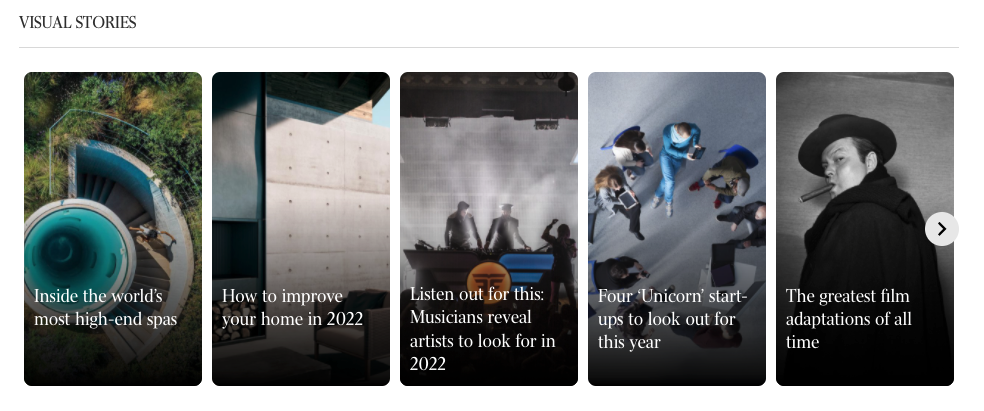
The Australian features their top Web Stories in a carousel on their homepage.
We recently began working with News Corp Australia to use Web Stories across their family of publications. For example, Australia's most prominent newspaper, The Australian, just added a Web Stories carousel to their homepage under the “Visual Stories” heading. They are using Web Stories for a variety of sections, including news, travel, lifestyle, arts and entertainment.
We are also working with News Corp brands in the U.S., like The Wall Street Journal, and hope to bring Web Stories to even more News Corp publications. In each project, we learn something new and try to share that experience globally.
The Home garages getting pandemic makeovers Web Story in The Wall Street Journal shares many garage renovations, including this transformation into a pub.
"News Corp Australia is producing more Web Stories a week than any other publisher in the world,” says Rod Savage, Partnership Editor of News Corp Australia. ”We could not output such volumes of quality content without a quality publishing system and XWP's plug-in has proven to be robust and intuitive. We're looking forward to continuing to build a mutually beneficial relationship with the common goal of making Web Stories a stunning user experience."
On the Google app on Android and iOS, News Corp’s Web Stories appear on Discover (currently available in the U.S., India and Brazil). This is a useful tool for reaching new audiences, and our customers are seeing positive results in their web traffic.
We’re also helping smaller, independent publishers use Web Stories to engage their audiences. For example, a COWGIRL Magazine Web Story promoted a documentary about Wyomingrodeo athlete Amberley Snyder, who built her life back after losing the use of her legs in an automobile accident.
COWGIRL Magazine used the Web Stories format to share how rodeo athlete Amberley Snyder began riding horses again after a car crash that left her paralyzed below the waist.
“It's a different way of telling a story online, unlike anything that anybody's doing out there,” says COWGIRL Magazine Founder and CEO Ken Amorosano. “[Social media stories are] rapid fire…but they’re not really telling a story. A blog post is telling a story, but it's out of sequence, as a photo doesn’t necessarily link with a paragraph. With Web Stories, every word with that image, with that video, matters. And it matters to the actual flow of the story. It has a beginning, middle and an end. And it's very, very, very powerful.” Check out my interview with Ken to learn more about their experience using Web Stories.
Over the years, we’ve learned a lot about how to develop, deploy and enhance Web Stories for publishers. We’ve found that you can't just take an article and break it up into pages with text — it has to be more engaging. Web Stories offer the ability to add video, sound and images, and publishers need to find the right balance of using multiple media to tell their stories. When we start with publishers, the first thing we do is look at some existing stories. Then we encourage them to think about how to transform them into immersive Web Stories.
We can’t wait to see where Web Stories take XWP and our publishers next. That includes working with Google to develop Web Stories for WordPress, and helping even more of our customers experiment with Web Stories to grow their audiences and create new reader experiences.
by Amit Sion via The Keyword
